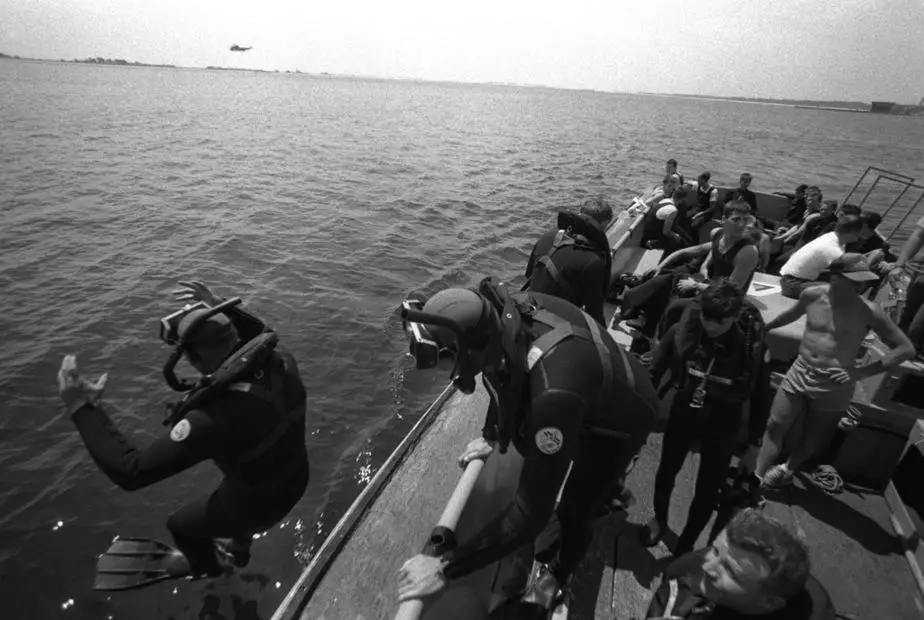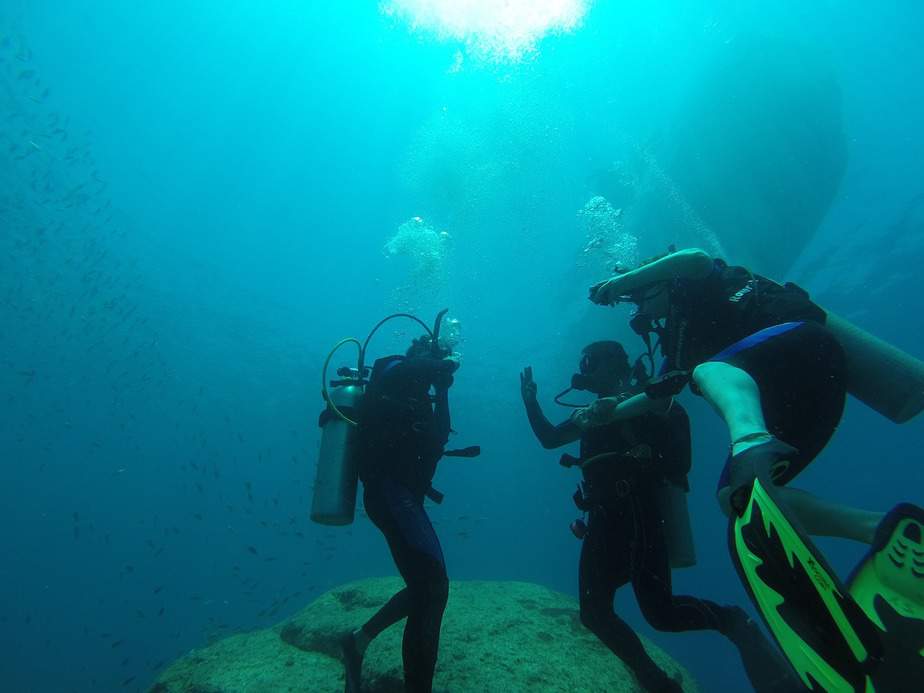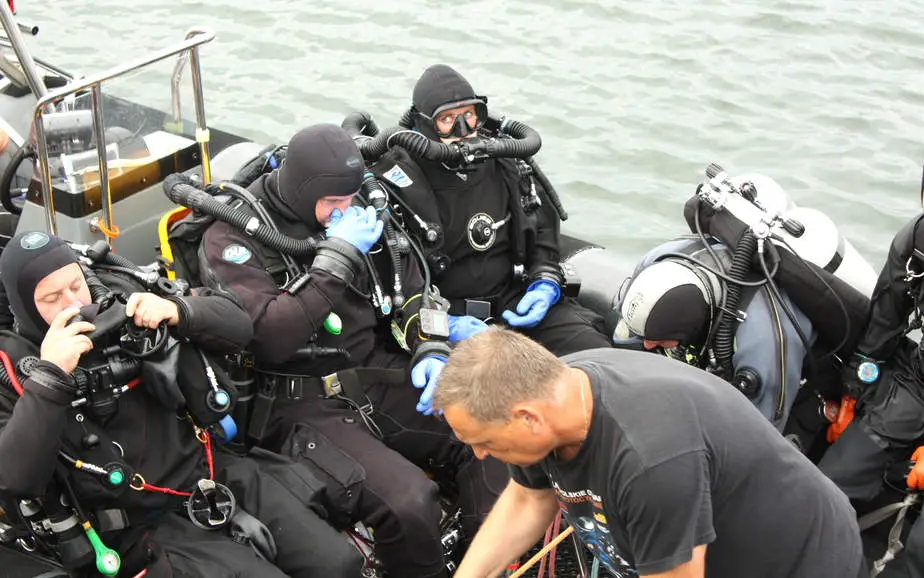The dive buddy check done before every dive is a crucial safety check that every diver should do. Unfortunately, many divers don’t do it, or they do it haphazardly. It’s not that they don’t know how to do it (though in some cases, that’s true), more that they are either too lazy or have outright forgotten how to do it properly. A dive buddy check is important to determine that equipment is fully functional and that divers haven’t forgotten something crucial like switching on the air.
To make the dive buddy check easier, scuba diving training agencies have come up with a memorable mnemonic: BWRAF. Think of it as the ABC’s of a dive buddy check; speaking of, ABC is another mnemonic you can use. BWRAF stands for: BCD, Weights, Releases, Air supply, and Final okay. Another version, ABC, stands for: Air, Buoyancy, and Clips. We will go over what each step means in more detail, however doing a dive buddy check ensures that both you and your dive buddy’s kit are in good working order before you enter the water.
If you need a refresher on how to do a dive buddy check, and want to learn more about BWRAF and how this mnemonic can help you remember all of the steps of the buddy check, then you are reading the right article. Additionally, we will also discuss the advantages of doing a buddy check, why it’s not done sometimes, and why it should always be done. Let’s dive in.
Why don’t divers do buddy checks?

If the buddy check is as important as we say it is, how come divers skip it sometimes? Doing a buddy check is kind of like driving the speed limit. Who actually follows that rule perfectly? Some people find it to be an annoyance and may even get angry if you insist on it.
Experienced divers are the most likely to be complacent and dismissive of the importance of this check. They will argue that they’ve been on hundreds of dives with no issues, so why do they have to follow the buddy check? Unfortunately, when it comes to scuba diving, one small error is all it takes to lead to a fatal outcome, or at least an abrupt end to a dive if you’re lucky.
It’s much easier to find a problem and fix it while on the boat than to deal with it once you’re in the water. It can be quite alarming to see how frequently the buddy check is neglected, though occasionally you do get someone who is appreciative of being reminded to do a buddy check.
When I was starting out, there were a number of embarrassing times when I jumped into the water without even wearing fins or switching on my air. Thankfully, the conditions were good and the only thing that was hurt was my pride. However, if the water conditions were worse, it would have been quite dangerous. Luckily for me, my early mistakes were on the wholesome, lighthearted side, but this is not always the case.
Furthermore, if you’ve ever had to rescue someone from an air supply problem, you will begin to be a proponent of the buddy check. Divers who have had life-threatening situations occur underwater due to equipment failure and were lucky enough to survive lament not doing a simple dive buddy check that would have caught the issue before even getting into the water. Being subjected to an event like this, or even just witnessing it, is enough to focus the mind.
I am appealing to you to always perform a buddy check each time you dive. It doesn’t matter how deep the dive is or how experienced your buddy is. If you ask your buddy for a check and they refuse, then you should refuse to dive with them until you have both done a check. If someone asks you to do a buddy check, do so graciously.
Why you should do dive buddy checks
The reasons why you should do dive buddy checks are simple:
- They confirm that both you and your dive buddy’s diving equipment are in perfect working order.
- They confirm that you both have your air switched on.
- They ensure both divers are familiar with each other’s dive kit. This means knowing where your buddy’s alternative air sources are, if it is working properly, how to reach for them easily, etc.
- They help you not waste any time if an emergency situation arises because you can quickly assist your buddy with malfunctioning equipment (it rarely still happens despite the checks). Each second matters in a life or death situation.
- Lastly, the buddy check gives you both peace of mind. You will be able to enjoy scuba diving with less stress, and this can help alleviate anxiety or nervousness.
ABC or BWRAF?
As we mentioned, there are two mnemonics you can use to help you remember the steps to a buddy check: ABC and BWRAF. You can follow whichever one helps you remember the steps more easily. Heck, you can even come up with your own mnemonic as long as it gets the job done. However, the reason why ABC and BWRAF are so prominent is that that’s what the major scuba training agencies have come up with, so let’s just roll with it.
BWRAF
The mnemonic BWRAF was first coined by PADI to help divers remember the steps to do a thorough buddy check. It has since been adopted by many others and perhaps adapted into different versions. However, BWRAF is commonly taught, and here’s what it means.
B – BCD/Buoyancy
Check your buddy’s BCD. Inflate it fully to see if the emergency valve works, and then fully deflate it. Use all of the inflating and deflating valves available (there can be anywhere between 2 and 5 valves) and remember where each one is located and how to use them. Inflate the BCD one last time so that nobody is going to enter the water with an empty BCD.
Also keep an eye out for any entanglements. Make sure the quick-releases and toggles are not obstructed in any way. Since each manufacturer has a slightly different configuration, it’s important that you do this step to familiarize yourself with your buddy’s BCD.
A common mistake divers make is that they overlook the quick-release dump valve which may be trapped under a chest release or shoulder strap. This will prevent the BCD from fully inflating, causing issues with staying positively buoyant at the surface when you enter the water.
W – Weights
Many divers only double-check their own weights. However, if an emergency happens to your dive buddy, or if you need to assist them back onto a boat after a dive, you will be unfamiliar with their weight system and how to drop the weights in an emergency.
Not everyone has the same weight system. There are multiple weight systems a modern diver can use such as a weight belt, integrated weights, harnesses, trim weights, ankle weights, and any combination of these.
During the pre-dive check, figure out each other’s weight system. That means to show each other the location of all the dive weights and how to release them so as to make ascending easier during an emergency.
If your buddy is a newbie, you can help them figure out how to properly weight themselves. Ask them how many dive weights they have put into their weight belt or weight pockets, and see if they are properly aligned. Ideally, one should have a symmetric distribution of weights to keep them as close to the center of gravity as possible.
R – Releases
Loose cylinders or tank bands are problematic as well as embarrassing. It’s surprisingly common how often you can spot divers with loose cylinders as they return to the boat or the shore. Don’t be one of them.
The shoulder straps, cummerbund and clips need to be flat and secured tightly. None of them should be twisted. Ensure that any equipment that is hanging from yours or your buddy’s BCD are secured.
When you first get access to your BCD, make sure to soak the band/release in water. Moistening it helps it to relax and expand its webbing to its largest size before you strap in a tank. Not doing this means that the band will expand while underwater, which is what leads to many divers exiting the water with loose cylinders.
During the buddy check, make sure to give your dive buddy’s tank strap a firm tug to make sure it’s snug. Ask your buddy to do the same for you because it’s really hard to do it on your own.
A – Air
This is part of the pre-dive safety check to make sure your air is switched on and that it isn’t contaminated.
Check that your buddy’s air tank valve is fully open and have your buddy check yours. Do not “over-open” the tank valve; I always turn it all the way then turn it back a quarter of a turn. This small amount of turn does not affect airflow whatsoever.
When checking your buddy’s air, ask them to take a few full breaths from the regulator. As they do, keep an eye on their SPG. The reading should remain stable and not drop. If the needle noticeably drops, then something is wrong. The issue might just be that the air is not turned on. Do the same check for your buddy’s alternate air supply (octopus).
Many divers only take a quick glance at their SPG, see that it’s full, and consider that a successful check. You must actually take a few breaths to ensure that everything is working properly. Also, pay attention to how the breathing gas smells and tastes.
F – Final okay
Double check that you have all the gear you need for the dive at hand, and that the equipment is fully functional. That means checking your dive computer, defogging your mask, making sure your camera is ready, etc. Basically, ensure that all your accessories are present and working and nothing is twisted up, tangled, or missing.
When you’ve finished checking, it’s time to give the final okay. That means you confirm with your dive buddy, to the dive group, and the leader that you’re ready to dive. Do not give the final okay until you’ve done all of these checks.
Many divers do a lackadaisical job with their buddy check, if they do it at all. Missing accessories and gadgets are common problems. Don’t be that guy who, when the skipper brings the boat into position and everybody is about to dive in, suddenly realizes you’ve forgotten your dive computer in the cabin. Or the guy who isn’t set for the correct nitrox mix, or the guy who is missing his reel and SMB. Everybody is annoyed by that guy.
A good way to prevent being that guy is to do a thorough buddy check. You can remember each step in this process by remembering BWRAF. As they say, an ounce of prevention is worth a pound of cure, and following BWRAF will save you from a whole lot of grief than it causes.
ABC
If you are not a fan of BWRAF, then how about ABC? The ABC pre-dive check is part of the BSAC buddy check system, and is what is taught by Scuba Diving International (SDI) and Technical Diver International (TDI). Don’t be surprised if they are quite similar. Here’s what each letter means.
A – Air
Check that your air supply is switched on and that it is working properly. As part of your air check, also test if the gauge is working properly by taking a few full breaths from the regulator. If it is fluctuating wildly, something is wrong.
For instance, if the needle drops when you inhale, the culprit is likely that the valve is either closed or not fully open, or your air is turned off. Show your buddy your air gauge to double check. Say out loud what you are doing.
Smell and taste the air. Verbally confirm that it’s okay. Perform the same test on your alternate air source (octopus) as well. Doing this check in front of your buddy lets them know where the octopus is on your kit. They may need to use it at some point. Let your buddy know that you are okay with them using it during an emergency. Show your buddy how to detach it as well.
B – Buoyancy
Next, check that your air-in feeds work on your BCD or drysuit. Test it by pressing the auto-inflator button and putting in a small amount of air. Show your buddy where all the dump valves are in case of an emergency.
If you’re diving with a drysuit, let your buddy know which buoyancy method you’ll be using, e.g. BCD, drysuit, or both.
C – Clips and releases
Give all of your clips and releases a tug. Make sure each one is secured tightly. For any straps, make sure they are wet first so that they can expand to their full size before tightening them.
Explain to your buddy what weight system you are using, the location of all your weights, and how to remove them in an emergency.
Once you’ve given an overview of your equipment to your dive buddy, get them to show you their equipment. You should both have a good idea of how the other’s equipment works and where everything is.
Whether you prefer BWRAF or ABC, or whatever mnemonic you have come up with on your own, make sure you follow this process before each dive. We all like to think that nothing will ever go catastrophically wrong, but sometimes things can and do.
Doing a buddy check will reduce the likelihood of this happening, and even if it still does, at least you are in a better position to help your buddy or to receive help.
How to remember BWRAF
Even though the purpose of a mnemonic is to help you remember something, let’s be honest: BWRAF is not the easiest thing to remember. It’d help if it were an actually pronounceable word. If you’re daring enough, try actually pronouncing “BWRAF”; you will get weird looks, and somebody might think you were insulting them. Maybe the phonetic pronunciation of BWRAF is what helps make it memorable for you if you’re brave enough.
Thankfully, some funny, smart, and creative people have come up with a number of mnemonics for the mnemonic BWRAF. This hole keeps getting deeper, I wonder if it goes another layer deeper? Here are few examples (warning, some of these can be somewhat inappropriate):
- Being Wary Reduces All Failures (a common one).
- Because We Really Aren’t Fish.
- Blue Whales Really Are Fat (don’t ever say this to a blue whale).
- Bangkok Women Really Are Fellas (maybe don’t say this one out loud either).
- Breathing Water Really Ain’t Fun.
- Big Women Release Air Faster (interesting).
- Boy Waiting Really Ain’t Fun (ain’t that the truth).
- Big White Rabbits Are Fluffy (a really wholesome one for kids).
- Bruce Willis Ruins All Films (which is a lie, because Die Hard was amazing).
- Bruce Willis Rocks Action Films (an alternative to the above).
- Beer Wine Rum And Friends (amen to this).
- Beans/Breakfast With Rice and Fish.
- Blonde/Brunette Women Really Are Fun.
Surely from this list of examples, there are at least one or two that tickle your fancy. There are some normal ones, some silly ones, some inappropriate ones, some food-related ones, a few wholesome ones; there’s something for everyone.
If you’re not happy with any of these then we encourage you to come up with your own. If it works for you then it’s a great mnemonic and don’t let anyone tell you otherwise.
Let’s decrease the number of diver fatalities

I recently wrote an article about whether scuba diving is dangerous or not. According to the data and also based on my experiences, my conclusion was no, scuba diving is not dangerous. If people were dying left and right then scuba diving would not be such a popular sport like it currently is, though admittedly, some types of diving can be quite extreme.
However, during my research, I came across an interesting statistic, which is that there were between 127 to 169 scuba diving deaths worldwide from the years of 2010-2016, with typically around 50-60% of the deaths occurring in North America. It’s hard to calculate how many scuba dives were done in total because people can shore dive on their own which can skew the numbers.
In comparison, let’s look at the fatalities in another extreme sport: skydiving. According to the United States Parachute Association, “In 2020, USPA recorded 11 fatal skydiving accidents, a rate of 0.39 fatalities per 100,000 jumps. This is comparable to 2019, where participants made more jumps—3.3 million—and USPA recorded 15 fatalities, a rate of 0.45 per 100,000.”
Even a sport like skydiving, where one jumps from a plane thousands of feet in the air is somehow statistically safer than scuba diving by an order of magnitude.
I don’t tell you these statistics to scare you off from scuba diving, especially if you’re just getting started. I tell you them to encourage you to follow safety procedures. Doing a scuba dive buddy check, or pre-dive safety check, only takes a few minutes. If every diver took it more seriously, I bet scuba diving could easily have lower fatalities than skydiving.
Remember BWRAF or ABC; it could save you and your buddy’s life.


